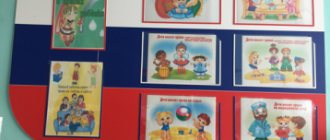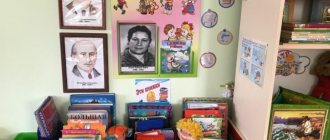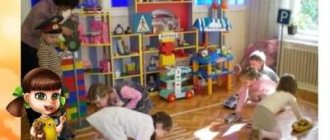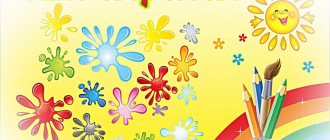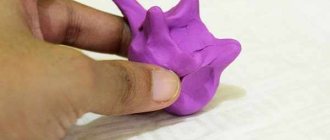Maintenance of environmental centers in groups of preschool educational institutions
Natalya Sugrina
Maintenance of environmental centers in groups of preschool educational institutions
Ugrina N.F.,
senior teacher
MBDOU No. 102
Maintenance of environmental centers in preschool educational institutions
The aggravation of environmental problems necessitates the formation of environmental consciousness and a culture of environmental management among the population. This work begins in the preschool educational institution, the first link in the lifelong education system.
Preschool childhood is the initial stage of the formation of a person’s personality, his value orientation in the world around him. During this period, a positive attitude towards nature, towards the “man-made world”
, to yourself and to the people around you.
Children's activities cannot be complete outside the subject environment, otherwise the child's desire to learn new things will disappear, apathy and aggression will appear. The surrounding space will help to avoid them, meeting the requirements of the current immediate and long-term creative development of each child, contributing to the timely identification and development of his abilities. An integral part of this space in a preschool educational institution is an ecological and developmental subject environment .
A specific feature of the method of environmental education for preschoolers is the child’s direct contact with objects of nature, “living”
communication with nature and animals, observing them, understanding what was seen during the discussion.
Indirect knowledge of nature (through books, slides, paintings, didactic games, etc.)
is also important: its task is to expand and complement the impressions that the child receives from direct communication with nature.
Therefore, in a preschool institution it is necessary to create environmental centers as important components of the ecological and developmental environment .
The main task of a developing ecological environment is to create conditions for the formation in children of a consciously correct attitude towards nature. The process of developing a consciously correct attitude towards nature is accompanied by independent observations, conducting experiments, and the child’s desire to talk about his experiences and impressions, discuss them, and embody them in various activities.
We have created environmental centers in each group . This allows the teacher to use them throughout the school year to conduct environmental and pedagogical activities and organize various types of children's activities: productive, communicative, labor, play, cognitive-research, musical-art, motor, perception of fiction.
Let's consider the content of environmental centers in the context of children's activities.
To organize productive activities of environmental content , card indexes of models for art activities were created, natural material for construction, attributes for non-traditional drawing, models of natural zones, biocenoses, models based on the works of writers V. Bianki, K. Ushinsky and others were collected. The most various natural materials: chalk, sand, stones, shells, feathers, coal and so on.
To organize gaming and communication activities in groups , games were selected to develop communication skills in preschoolers with environmental content , role-playing games “Tourists”
,
“Underwater World”
,
“Rural Yard”
. The teachers came up with and made various didactic games:
“On a tree - on the ground”
,
“Domestic and wild animals”
,
“Animals and babies”
,
“Match a leaf to a tree”
,
“Anthill and its inhabitants”
,
“Spring flowers”
,
“Day-night”
,
“Monkeys on a tree”
,
“Seasons”
.
Cognitive and research activities play a big role in the development of preschoolers’ cognitive interest and their creative activity. In all groups, scientist corners have been created to organize children's research activities in nature. Even the children of the first junior group , together with the teacher, conduct simple experiments. Microscopes, a globe, laboratory equipment, measuring glassware - all this is of particular interest to children. Children's experimentation not only provides children with an awareness of the connections and dependencies that exist in the natural world, but also provides an opportunity to practically master the basic skills necessary for organizing environmentally competent care for grown plants.
an ecological has been operating for many years - a natural area specially equipped for educational purposes, where conditions are created for educational and research activities. During walks and excursions along the ecological trail, children play , experiment, observe, learn not just to look, but also to see what surrounds them, and to talk about their impressions. They gain skills in time and space orientation and make sketches from life. They develop thinking, speech, memory. And most importantly, a sense of beauty appears, a love for nature is fostered, a desire to protect and preserve it. The green area of a preschool educational institution is of particular importance in an urban environment, where children are maximally isolated from the natural environment.
Each group “window gardens” since February.
, where there are onions, garlic, grain crops, flower seedlings. Children really enjoy watching plants. In addition to observation, they develop a sense of responsibility for the work they have started. The state of nature is noted daily and a corresponding picture is placed on the calendar. We try to encourage children, recognizing the most observant, diligent and active.
To organize work activities in the environmental center , materials and equipment for work activities have been collected (aprons, rags, sponges, oilcloth, spray bottle, watering cans, rakes, etc.) When selecting them, we took into account that materials and equipment must have a quality certificate and meet hygienic, pedagogical and aesthetic requirements.
Musical and artistic activities of environmental content are most fully reflected in the children's holidays “Visiting Autumn”
,
“Water Sorceress”
,
“Meet the Birds!”
,
“Earth Day”
and others. Holding such holidays helps children develop a sense of belonging to all life on the planet and fosters a caring attitude towards nature. During such events, competitions, games, competitions are usually held, exhibitions of children's drawings and photographic materials are organized, which also contributes to children's emotionally positive attitude towards the natural environment.
The environmental center contains works of art about nature: fairy tales, short stories, riddles, poems, proverbs and sayings, as well as models for telling poems and fairy tales.
The success of environmental education and training in preschool educational institutions depends on the use of various forms of work and their reasonable combination. When organizing work in different objects of the ecological and developmental environment, teachers of our preschool educational institution use various methods and forms of work with children, such as: didactic games, systematic observations, creating problem situations, experimental activities, organizing integrated classes, natural history conversations, the use of natural history literature, project activities, organization of excursions and hikes, environmental campaigns, holding holidays and leisure activities, labor activities to care for natural objects.
Thus, as a result of the application of modern approaches to environmental environmental education increases , which is expressed in a qualitatively new attitude towards nature. The leading personal achievement of a child becomes a truly humane attitude towards the greatest value - Life.
Literature
1. Nikolaeva S. Joint activities of adults and children // Preschool education. 2000. No. 5. P. 36-38.
2. S. N. Nikolaeva. Young ecologist : Program for environmental education of preschoolers. – M.: Mosaic-Synthesis. 2004.
3. O. V. Dybina, N. P. Rakhmanova, V. V. Shchetinina. The unknown is nearby - M.: Creative Center Sphere , 2001.
4. N. A. Ryzhova. Not just fairy tales. -M.: Linka-press, 2002.
5. Novoselova S. L. Developmental subject-game environment. // Preschool education. - No. 4. 2005.
What is it needed for?
A place that will introduce children to the world around them should be in all groups. Teachers and the children themselves pay a lot of attention to its design and management. Why is this needed?
There are many goals for working with such visual material:
- environmental education is carried out. In addition, corners of nature in kindergartens develop neatness and a sense of responsibility in children;
- Such places educate and form aesthetic feelings. Having created the necessary conditions, you can grow indoor flowers of different types. This allows children to enjoy a variety of beauty. Preschoolers, seeing this, experience aesthetic pleasure;
- One of the purposes of creation is educational. Children, under the supervision of teachers, work, care for plants and watch how they change throughout the year. They form a connection with them and with phenomena. They learn to water flowers, paying attention to what time of year it is. If it is summer, then watering should be plentiful, if it is winter, then the volume of water is reduced;
- This place develops flower care skills. Kids learn to care for them, water them, wipe dust from window sills, and other types of work;
- the presence of such a place is an opportunity to decorate the group’s room, make it more interesting, more fun for the gameplay.
Stand (corner) “Eco-children - young conservationists”
“The planet will become a better place if children help it!”
“The world is so magical and huge, you take care of it like a fairy tale!
For future generations, preserve nature in its original form!”
In our kindergarten, children from a young age begin to gain insight into the fascinating world around them.
In order for our students to learn to understand the world around them, realize that they are part of it, and establish connections between natural objects, we created an ecological stand-corner “Ecolyata”.
The purpose of the stand (corner): Formation of a rich inner world of pupils, a careful attitude towards their native nature, its flora and fauna, awareness of the need to preserve the protection and salvation of nature. Fostering a culture of love for nature, developing creative abilities.
Ecological corner “Ecolyata” is one of the play and educational areas of the ecological room. In the center of the stand is a tree with the “Commandments of Nature”; it is presented in bright rich colors, which adds color and a sunny mood to the atmosphere of eco-activity.
The name of the corner is “Ecolyata”, the motto is “THE PLANET WILL BE BETTER IF CHILDREN HELP IT!” , there is an emblem, an oath, an anthem.
Our stand performs an educational and informational function and consists of functional environmental sections.
In the ecological corner “Ekolyata” our pupils will have magical and extraordinary meetings with fairy-tale friends – Ecolyats , who immerse the children in the mysterious world of ecology and introduce them to the secrets of nature. The kind Lesovichok sends the Ekolyat to the children so that they can tell them how to protect and preserve the forest and love nature.
Clever , she tells children what water, air, forests, soil, animals, plants, including medicinal ones, are for. Introduces our students to encyclopedias and environmental books.
With a very sociable and cheerful Christmas tree , children play environmental games and participate in various projects. The children learn poems, sing songs, and make crafts together with their parents.
Quiet continues to introduce the children to animals and plants, repeats the rules of behavior in nature with the children, and gives the children tasks to care for indoor plants (geranium, begonia) that are located in the ecological corner. In the process of observing natural objects, combined with the work of caring for them, children form ideas about plants, their growth and development, and changes depending on the season. In the autumn-winter period, there is a mini-garden on the windowsill in which seedlings of vegetable, grain and flower crops grow.
Tikhonya also introduces children to the underwater world with the help of an aquarium with fish, shells, and shells, which children love so much.
Shalun introduces parents to information of an educational and educational nature. These are consultations, booklets, memos. Introduces children to a photo report of environmental activities: experimentation at the Miracle Pond, introducing children to the farmstead of the village of Andreevka, the vegetable garden, grain garden and the diversity of the flower garden.
The eco-kids introduce children to an ecological lapbook, which includes the Christmas tree Umnitsa’s information from the “mini-encyclopedia “Why do animals disappear?”, Tikhonya’s “Who created nature or man?”, Shalun’s , how to sort garbage.
Together with all the heroes – the Eco-children, we are holding “Bird Feeder!” campaigns. “Plant a flowerbed!”, environmental cleanup “Let’s clean the planet of garbage!” and competitions “Oasis” and “Vegetable Garden on the Window”. Eco-children lead children on an exciting journey along the Ecological Trail of our kindergarten. And together with all the heroes we have fun!
In a mini-laboratory, children, under the guidance of a teacher, conduct experiments (a card index of experiments in nature has been selected). In summer and autumn, children, together with teachers and parents, collect herbariums of plants and natural material. Our students learn to work with scientific equipment: a microscope, scales, use flasks, beakers, and bulk materials for research.
When organizing work in various objects of the ecological and developmental environment, we use didactic games, observations, creating problem situations, experimental activities, integrated classes, and natural history conversations, which is a unique opportunity for children and parents to study, protect nature, and make friends with it. The corner is a place for systematic work and observation of pupils, where they have the opportunity to demonstrate maximum activity and independence. Thus, the “Ecolyata” corner, which we have carefully arranged for our little Pochemucheks, helps them grow up as people who are not indifferent to the problems of the Earth’s ecology.
A. M. Gorky Fr.
This stand helps to create conditions for developing children’s interest in nature and natural phenomena, helps to notice the beauty of nature at different times of the year, fosters a caring attitude towards the animal and plant world, the ability to behave correctly in nature, encourages curiosity and contributes to the development of children’s creative abilities.
In addition, children develop cognitive and research abilities and work skills.
We can confidently say that our kindergarten students are growing up to be TRUE FRIENDS AND DEFENDERS OF NATURE!
And we will continue our environmental activities under the motto: “THE PLANET WILL BE BETTER IF CHILDREN HELP IT!”
In addition, in a corner of nature in each group it is necessary to have:
- Natural vegetables and fruits, or their dummies.
- Sets of pictures depicting animals, birds, insects and more.
- Albums "Seasons"; books with illustrations depicting animals; paintings by famous artists.
- Children's drawings about nature and crafts made from natural materials.
- Material for labor. Aprons, watering cans, spatulas, loosening sticks, and rags are useful for caring for indoor plants. Brooms and dustpans - to maintain cleanliness in a corner of nature and a group.
- Equipment for experiments. Molds, funnels, shovels, sieves will be needed for playing with sand. To play with water, you can use pipettes, disposable syringes, and containers of various shapes. To make crafts, you need natural and waste materials (shells, pebbles, pine cones, acorns, chestnuts, twigs). For children in the preparatory group, working with a magnifying glass, microscope, and scales will be interesting.
- Didactic games with natural content “Who eats what?”, “Whose house?”, “Whose baby?” and others.
Filling the corner of nature with the necessary material will depend on the age of the children and the requirements of the Education Program.
A corner of nature is necessary not only for observations. It also contributes to the formation of labor skills. Already from the younger group, children are involved in carrying out individual work assignments. And from the senior group, duty in a corner of nature is introduced.
Presentation of the ecological corner “Ecolyata-Preschoolers”
An amazing phenomenon of nature is that its educational impact on the inner world of a preschooler is difficult to overestimate, since the child’s soul is fully revealed only in communication with nature. As part of the socio-educational project “Ecolyats - Preschoolers”, an ecological corner was created in our kindergarten, which is a place of educational activity for students, where they have the opportunity to learn to understand the world around them, realize that they are part of it, and establish connections between natural objects. The versatility of the corner lies in the fact that it is available to students throughout the school year; teaching material is updated depending on the time of year; children can clearly see the seasonal changes occurring in nature.
At the top of the corner there is the “Ecolyat” logo, and the owners of the corner are the fairy-tale heroes of the ecolyt, already loved by preschoolers, who help them get acquainted with the world around them.
With Naughty, students play various games and experiment. Research activities are of great interest to preschoolers; for them, experiments are like magic tricks. Children's experimentation not only provides children with an awareness of the connections and dependencies that exist in the natural world, but also provides an opportunity to practically master the basic skills necessary for organizing environmentally competent care for grown plants.
The card index of environmental games created by preschool teachers for each age group helps to diversify the play activities of students.
With Clever Girl, preschoolers read books and solve environmental situations. The ecological corner contains works of art about nature: fairy tales, short stories, riddles, poems, proverbs and sayings, as well as models for telling poems and fairy tales. Throughout the year, various environmental projects are implemented together with children. And the results in the form of layouts, collections, laptops are placed in the corner of the ecology.
With the Christmas tree, children learn to care for indoor plants and pets. In the process of observing natural objects, combined with the work of caring for them, children form ideas about plants, their growth and development, and changes depending on the season.
Also in our ecological corner there is an aquarium with beautiful fish, a turtle and a favorite of teachers and children - the Chilean degu squirrel. The guys watch with interest and look after them.
With Tikhonya, preschoolers collect interesting collections (shells, stones, cones, seeds, leaves, plant fruits) for experimental activities.
The environmental corner contains important information for children and their parents, achievements, reminders, booklets, and colorful pictures. Parents and teachers will learn about upcoming environmental and environmental events, summing up the results of thematic environmental competitions and quizzes from the “Rosinka Environmental News” section.
Permanent inhabitants of this corner of nature will be indoor plants:
- In the younger group of indoor plants, 4-5 types of unpretentious plants are recommended. These are plants that bloom beautifully and for a long time, with distinct stems, leaves and flowers. For example, ficus, primrose, balsam, coleus, geranium.
- In the middle group, the number of indoor plants increases to 5-6 species. These will be plants with different shapes and sizes of leaves. For example, asparagus, agave, chlorophytum.
- In the older group, 6-7 plant species, 2-3 specimens each, with various stems (climbing, creeping), having bulbs and corms are placed in a corner of nature. For example, tradescantia, ivy, amaryllis and others.
- In the preparatory group, 6-7 species of plants are placed in a corner of nature, which reproduce in various ways: by bulbs, viviparous. As well as flowers with different growing conditions. For example, bryophyllum, saxifrage, cyperus.
